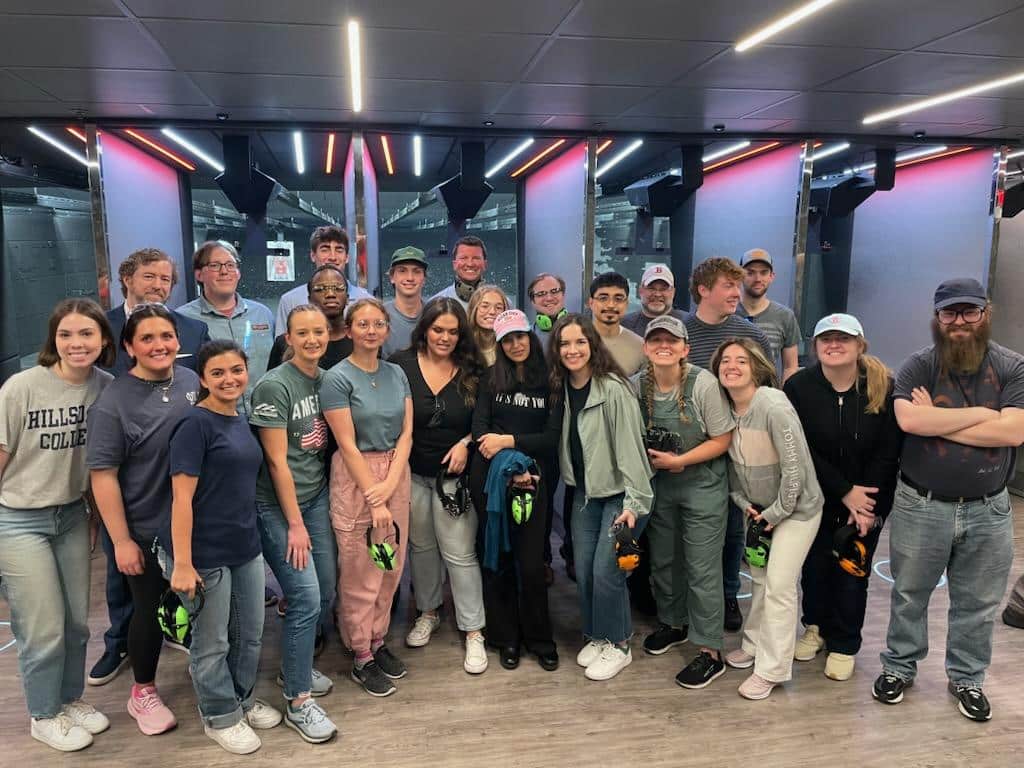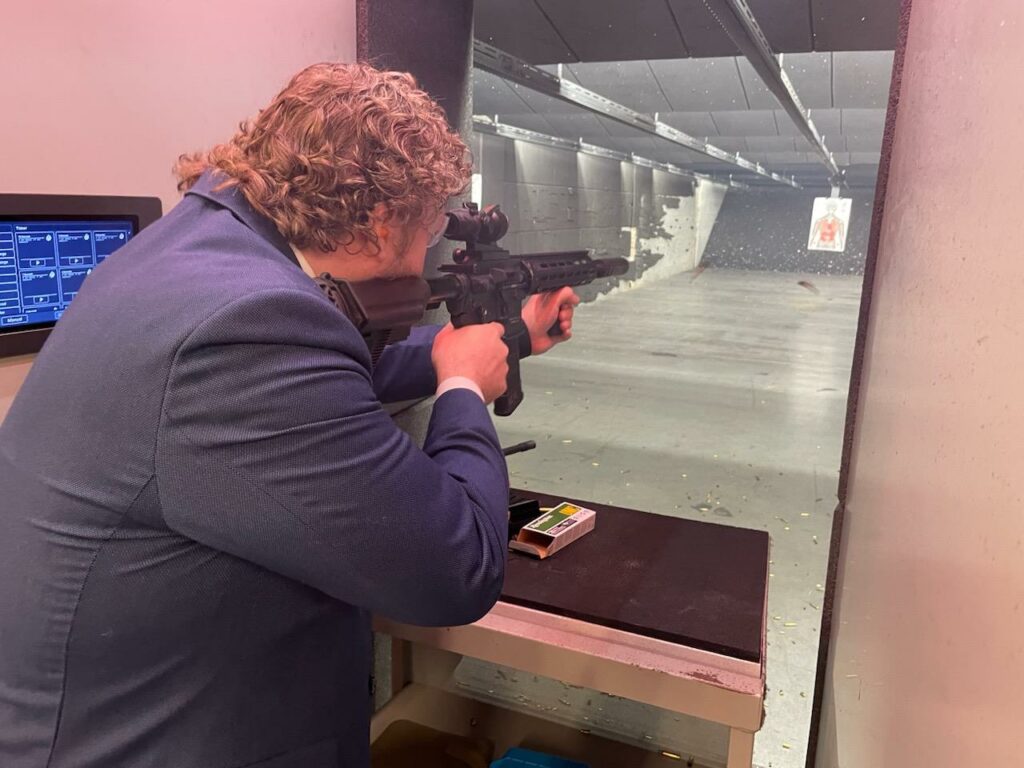The news has kept me very busy this week. The Supreme Court doing a Friday opinion release was a big part of that. One of those opinions resulted in a majority striking down the bump stock ban.
I predicted that would probably happen. But that doesn’t mean The Court didn’t throw us some surprises. In fact, the conservatives effectively endorsed a legislative bump stock ban. I do my best to explain how they square that with the Bruen standard, if at all.
I also give a recap of my latest gun reporting class and range day with the National Journalism Center.
Plus, Cam Edwards of Bearing Arms joins the podcast to examine the Hunter Biden gun crime convictions. Then, Contributing Writer Jake Fogleman looks at the various gun groups’ mixed reactions to the verdict.

Supreme Court Strikes Down Bump Stock Ban
By Stephen Gutowski
The Supreme Court has found the bump stock ban is unlawful.
In a 6-3 ruling, the Court ruled the ban is inconsistent with the federal law the Bureau of Alcohol, Tobacco, Firearms, and Explosives (ATF) used to justify it. The majority said the ATF exceeded the authority Congress granted it under that law. The decision effectively undoes the ATF’s ban, which was imposed under former president Donald Trump.
“In any event, Congress could have linked the definition of ‘machinegun’ to a weapon’s rate of fire, as the dissent would prefer,” Justice Clarence Thomas wrote for the majority in Cargill v. Garland. “But, it instead enacted a statute that turns on whether a weapon can fire more than one shot ‘automatically . . . by a single function of the trigger.’ And, ‘it is never our job to rewrite . . . statutory text under the banner of speculation about what Congress might have done.’”
The decision makes bump stocks legal to own once again, years after the ATF ordered owners to turn them in or face potential felony charges. It represents a setback for former president Donald Trump, who instituted the ban and has continually stood by it to the distain of some gun-rights advocates. However, it also imperils many of President Joe Biden’s executive actions restricting firearms because they were carried out using the same ATF rulemaking process–often with similar flip-flops on a restriction’s legality from the agency.
The Court took issue with the ATF’s reversal of where bump stocks fit into federal regulations.
“For many years, the Bureau of Alcohol, Tobacco, Firearms and Explosives (ATF) took the position that semiautomatic rifles equipped with bump stocks were not machineguns under the statute. On more than 10 separate occasions over several administrations, ATF consistently concluded that rifles equipped with bump stocks cannot ‘automatically’ fire more than one shot ‘by a single function of the trigger,’” Thomas wrote. “In April 2017, for example, ATF explained that a rifle equipped with a bump stock does not ‘operat[e] automatically’ because ‘forward pressure must be applied with the support hand to the forward handguard.’ And, because the shooter slides the rifle forward in the stock ‘to fire each shot, each succeeding shot fir[es] with a single trigger function.’”
The majority noted the ATF “abruptly reversed course” after a shooter used a collection of firearms, including several equipped with bump stocks, to murder dozens of people at a music festival in Las Vegas, Nevada. Thomas said the ATF’s ‘”earlier regulations simply restated” the machinegun law, but the new rule “amended those regulations by adding” a new definition. Ultimately, the Court found bump stocks simply did not meet the technical definition of “machinegun” under federal law.
“A semiautomatic rifle equipped with a bump stock does not fire more than one shot ‘by a single function of the trigger,’” Thomas wrote. “With or without a bump stock, a shooter must release and reset the trigger between every shot. And, any subsequent shot fired after the trigger has been released and reset is the result of a separate and distinct ‘function of the trigger.’ All that a bump stock does is accelerate the rate of fire by causing these distinct ‘function[s]’ of the trigger to occur in rapid succession.”
The ruling does not touch on the Second Amendment or whether bump stocks could be banned by an act of Congress. Instead, it was wholly limited to whether the ATF exceeded its authority under current law. The Court has yet to release US v. Rahimi, the only case this session dealing with a direct Second Amendment question, but the ruling is expected by the end of the month.

Analysis: A Puzzling Aspect of the Supreme Court’s Bump Stock Ruling [Member Exclusive]
By Stephen Gutowski
A majority of the justices on the nation’s highest court rebuked the ATF’s attempt to ban bump stocks by administrative rulemaking this week. However, several also expressed a curious openness to prohibiting the devices through other means.
On Friday, the Supreme Court handed down a decision against the ban in Cargill v. Garland. A 6-3 majority found the ATF had exceeded its authority under the National Firearms Act by reclassifying bump stocks as machineguns. The Court focused on the fact that bump stocks don’t fire more than one round per “function of the trigger,” as required to qualify as a machinegun under the law.
The majority opinion did not declare the Second Amendment protects bump stocks, which isn’t surprising since the challenge didn’t claim that. What is surprising is how many of The Court’s conservatives went out of their way to suggest the Second Amendment doesn’t protect bump stocks.
While all of the conservative members of the Court joined the majority in striking down the ATF ban, half of them expressed sympathy for its goal at one point or another. The first two instances came during oral arguments in the case. Justices Amy Coney Barrett and Neil Gorsuch implied they think the stocks, which help a shooter bump fire to reach a higher rate of fire than traditional shooting methods, shouldn’t be available to civilians.
During her questioning of the government, Barrett said she “can certainly understand why these items should be made illegal.” Her only real hangup with the ban was the way the ATF read it into existence.
“Look, intuitively, I am entirely sympathetic to your argument,” she said. “I mean, it — and it seems like, yes, that this is functioning like a machinegun would. But, you know, looking at that definition, I think the question is, why didn’t Congress pass that litigation — I mean that legislation to — to make this cover it more clearly?”
“Maybe they should have written something better. One might hope they might write something better in the future,” Gorsuch added. “But that’s the language we’re stuck with.”
Then, Justice Samuel Alito doubled down on his colleagues’ questions in a concurrence to Friday’s ruling.
“There can be little doubt that the Congress that enacted 26 U. S. C. §5845(b) would not have seen any material difference between a machinegun and a semiautomatic rifle equipped with a bump stock,” he wrote. “There is a simple remedy for the disparate treatment of bump stocks and machineguns. Congress can amend the law—and perhaps would have done so already if ATF had stuck with its earlier interpretation.”
“Now that the situation is clear, Congress can act,” Alito concluded.
More surprising, and perhaps alarming to gun-rights activists, is the lack of an explanation for how such a ban comports with the history and tradition standard set by the same majority just two years ago in New York State Rifle and Pistol Association v. Bruen. The three conservative justices simply assert bump stocks can be banned just by Congress instead of the ATF. They don’t wrestle at all with the idea the Second Amendment protects them.
Under Bruen, the government is meant to justify modern firearms restrictions using historical analogues that date to the Founding Era. The National Firearms Act, the underlying law the justices suggest amending to include bump stocks, only dates to 1934. Alito, Barrett, and Gorsuch haven’t offered up any historical analogues to justify it.
That’s a bad sign for anyone hoping the Supreme Court would use the Bruen standard to strike down most modern gun prohibition based on the relatively sparse Founding Era regulations.
It isn’t wholly unexpected to anyone who has watched The Court’s gun jurisprudence since it began finally developing one less than 20 years ago. Bruen may be the most recent and expansive standard developed by The Court to handle Second Amendment cases, but it isn’t the only one. US v. Heller set a different, though not necessarily contradictory, standard for what weapons are protected based on whether they are in common use by American civilians.
“Read in isolation, Miller’s phrase ‘part of ordinary military equipment’ could mean that only those weapons useful in warfare are protected,” the Heller majority wrote in reference to a previous Second Amendment ruling. “That would be a startling reading of the opinion, since it would mean that the National Firearms Act’s restrictions on machineguns (not challenged in Miller) might be unconstitutional, machineguns being useful in warfare in 1939. We think that Miller’s ‘ordinary military equipment’ language must be read in tandem with what comes after: ‘[O]rdinarily when called for [militia] service [able-bodied] men were expected to appear bearing arms supplied by themselves and of the kind in common use at the time.’ The traditional militia was formed from a pool of men bringing arms ‘in common use at the time’ for lawful purposes like self-defense.”
So, The Court believes the Second Amendment historically protected guns that were owned by the general population because they were the ones expected to turn up for militia service. That means any firearm that isn’t part of that to-this-point-vaguely-defined category is fair game for government regulation.
“We therefore read Miller to say only that the Second Amendment does not protect those weapons not typically possessed by law-abiding citizens for lawful purposes, such as short-barreled shotguns,” the majority wrote. “That accords with the historical understanding of the scope of the right.”
The ATF estimated there were about half a million bump stocks in circulation before the ban. That’s far fewer than handguns, which The Court found were protected under the common use standard. But it’s more than the stun guns that the Court found were protected. The Supreme Court has never given a hard number on what qualifies as “common use.”
Although, ironically, Alito’s concurrence in the stun gun case came the closest when he asserted that the estimate of 200,000 tasers put them in the protected category.
“The more relevant statistic is that ‘[h]undreds of thousands of Tasers and stun guns have been sold to private citizens,’ who it appears may lawfully possess them in 45 States,” he said. “While less popular than handguns, stun guns are widely owned and accepted as a legitimate means of self-defense across the country. Massachusetts’ categorical ban of such weapons therefore violates the Second Amendment.”
The flip side of “common use” is the “dangerous and unusual” standard. If a weapon hits both qualifiers, the government can ban it under Heller. The Justices seem to view bump stocks as especially dangerous. But Alito’s concurrences have muddied the water on the second point.
Regardless, his concurrence, combined with his conservative colleagues’ comments in oral arguments and the liberals’ dissent arguing bump stocks should already be banned under current law, suggest a new bump stock ban law would probably survive a Second Amendment challenge. It also indicates most of the conservative justices view Bruen as a less severe burden on the government’s ability to restrict firearms than many in the gun-rights legal movement do. Look for that basic truth to come through in The Court’s upcoming ruling in US v. Rahimi, too.
Podcast: Hunter Biden’s Gun Convictions and the NRA’s New CEO (Ft. Bearing Arms Cam Edwards) [Member Early Access]
By Stephen Gutowski
This week, a jury found the President’s son guilty of federal gun felonies.
We’ve got one of the country’s best and most prolific gun writers on the show to discuss that development. Cam Edwards is the editor of Bearing Arms and the host of Cam and Company. He said he wasn’t surprised by Hunter Biden’s conviction but wasn’t necessarily celebrating it.
He said the evidence against Hunter was formidable and noted the vast majority of federal charges that make it to trial end in a guilty plea or conviction. Still, he questioned the underlying law that Hunter was convicted on. He said the First Son has a real chance at a successful Second Amendment challenge.
Cam also gave us insight into his recent interview with new NRA CEO Doug Mills. It was one of Mills’s first long-form interviews, and Cam said the venue sent as much of a message as anything they discussed. That’s because Cam has been a vocal critic of the mismanagement and corruption of the gun group’s previous leadership.
Still, Cam said he was also encouraged by what Mills did say about his commitment to transparency and change. But he is also hoping to see more concrete signs of movement from the NRA before fully returning to the fold.
The show is brought to you by The Dispatch. Click here to get a month-long free trial!
You can listen to the show on your favorite podcasting app or by clicking here. Video of the episode is available on our YouTube channel. An auto-generated transcript is available here. Reload Members get access on Sunday, as always. Everyone else can listen on Monday.
Plus, Contributing Writer Jake Fogleman and I walk through the Supreme Court’s ruling striking down the ATF’s bump stock ban as unlawful on the news update. We also discuss what the ruling might mean for President Biden’s gun executive orders and what it might say about the Justices’ appetite for striking down machine gun bans. We cover the interesting politics of a gun tax ballot initiative set to go before Colorado voters this fall and recap my experience at the National Journalism Center’s range day.
National Journalism Center Range Day
Friday was a very busy day for me. The Supreme Court, in complete disregard of my personal schedule (!), decided to drop Cargill. That meant I was on CNN quite a bit (you can watch my interview on The Lead with Jake Tapper here). That was good, but it also sent me scrambling because Friday was also when my latest range day with the National Journalism Center was scheduled.
This range day was a particularly large event, which was nice to see. I was able to give my lesson on the complexities of accurately covering firearms policy and politics. It’s ignorance that I think does the most damage in gun reporting, both to the audience’s understanding of the issue and to journalists’ reputations.
Ideological bias plays a role in bad reporting on guns but it’s ignorance that’s the biggest problem. Luckily, it’s one that’s also easier to address. And that’s the goal of these range days. We do a classroom portion where I go over the common issues at the center of the American gun debate and the common mistakes made when reporting on them.
Then, there’s a safety briefing. Then, we head to the range for some real-world experience handling and shooting various firearms.
I’m not usually so well dressed for this event, but it ended up sandwiched between multiple CNN interviews. So, I looked a bit classier than normal on the range. But the important part is everyone was safe and learned quite a bit from the experience.
I look forward to doing it again soon and expanding the program beyond the National Journalism Center in the future.

Analysis: Hunter Biden Verdict Divides Gun Activists [Member Exclusive]
By Jake Fogleman
What do you get when the son of the most gun-control-focused President in a generation is convicted of violating federal gun control laws? Among many advocates in the gun space, the answer is a whole lot of discomfort in determining whether and how to respond.
A Delaware jury delivered a unanimous guilty verdict Tuesday morning against Hunter Biden. It convicted him of lying to a federally licensed gun dealer, making a false claim on a federal background check form by saying he was not an unlawful drug user, and illegally possessing a firearm as a user of a controlled substance.
It’s an outcome almost tailor-made to scramble the politics of our current moment.
Hunter Biden’s Second Amendment defense, which relies on an avenue created by the Supreme Court’s conservative majority in New York State Rifle and Pistol Association v. Bruen, should be at least somewhat popular among the pro-gun. However, as Americans have become increasingly polarized along partisan lines, Republicans and conservatives have become the de facto coalition championing gun rights. His status as Joe Biden’s son automatically tempers support for anything he does among those on the other side of the aisle from his father.
Additionally, Hunter Biden has become a bête noire among the same group in recent years. His infamous laptop and its contents, which included pictures of him engaged in illicit activity and emails about his overseas business dealings, were briefly suppressed by social media platforms and news outlets before the 2020 election, leading many Republicans to cry foul. Many also believe President Biden improperly benefitted from Hunter’s overseas activities, spurring House Republicans to launch an unsuccessful impeachment inquiry earlier this year.
On the other side of the coin, Hunter’s father is the most powerful Democratic politician in the country and has become a hero of the American gun control movement. He has delivered more gun-control action than any other President in decades. So, those who support strict gun laws and might otherwise cheer a conviction in Hunter’s case are predisposed to keep quiet out of deference to his father.
This political tension was inherent in the gun groups that did (and did not) choose to comment on a high-profile application of America’s gun laws.
Gun-Control Groups
Perhaps most notably, none of the country’s major gun-control groups has publicly said a word about Hunter Biden’s conviction.
The subject did not come up at Everytown For Gun Safety’s “Gun Sense University” event just hours after the verdict. That’s despite the fact that President Biden headlined the event and touted his administration’s work on keeping guns out of the hands of prohibited possessors, among other things.
Neither Everytown, Giffords, nor Brady has issued a public press release about the verdict, and each appears to be avoiding requests for on-the-record comments by news outlets. One gun-control group staffer told Politico on the condition of anonymity that the continued silence of gun-control advocacy groups is “all about politics.”
“This is just: ‘No, we’re not going to get in the middle of this shitstorm. Nothing good can come of it,’” they said.
Gun-Rights Groups
On the gun-rights side, most of the major players did chime in. However, their responses varied significantly, with some praising the verdict and others forcefully criticizing it and the law upon which it was based.
The larger, more established gun rights organizations like the National Rifle Association (NRA) and the National Shooting Sports Foundation (NSSF) fell into the former camp.
“NSSF has been a consistent supporter of keeping guns out of the hands of those who should not possess them, whether that be a prohibited individual, an unsupervised child or someone suffering a mental health crisis,” Mark Oliva, NSSF spokesman, told the Washington Examiner. “Hunter Biden’s admission that he was illegally using controlled substances and addicted to illicit drugs at the time of his firearm purchase clearly demonstrates that he was a prohibited individual at the time he purchased the firearm and lied on the ATF Form 4473 and attested he was not using illicit drugs.”
“The National Rifle Association has always stood for the lawful use and possession of firearms,” Randy Kozuch, executive director of the NRA Institute for Legislative Action, told the Examiner. “Mr. Biden’s documented lifestyle choices at the time of purchasing a firearm made him a prohibited person under current law.”
In the latter camp, groups like the Firearms Policy Coalition (FPC) and Gun Owners of America (GOA) used the occasion to blast the federal gun ban for drug users. FPC, in particular, took a forceful stand against the law and reiterated its previous offer to assist Hunter Biden’s legal team in fighting his case on appeal to have the law struck down.
“Countless lives are destroyed every year under the federal government’s unconstitutional and immoral regulations. We proudly work to eliminate these laws and create a free world,” Brandon Combs, FPC President, said in a press release. “Just as we have in many other cases, we stand ready to assist Mr. Biden in his challenge of federal gun laws.”
“Hunter Biden found GUILTY on three counts of violating unconstitutionally broad gun laws that shouldn’t even exist,” GOA announced from its official X account.
What It Means
Gun-control groups hesitating to opine on the verdict is not much of a surprise.
Despite their apparent commitment to seeing gun restrictions enforced, the major gun-control groups are no doubt sensitive to the political valence of this particular case. They know that getting their agenda passed and preserving their influence means staying in the good graces of influential Democrats. So, they likely don’t want to make the felony conviction of the President’s son an occasion to celebrate the virtues of the Gun Control Act as they might in other circumstances.
The more interesting dynamic is the divided approach taken by gun-rights groups. Here, too, the political valence of the case clearly matters, but in a different way. It speaks to a growing split between the larger, more traditionally conservative organizations and the scrappier, more libertarian-leaning Second Amendment organizations in how they respond to high-profile incidents where guns interact with other right-coded shibboleths.
For instance, a similar dynamic has also been apparent in other contexts, particularly controversial police killings of lawful gun owners. While groups like the NRA and NSSF have traditionally avoided speaking out in such cases and often tout their partnerships with law enforcement organizations, groups like FPC routinely offer fiery condemnations of law enforcement actions perceived as violating the civil liberties of gun owners.
The Hunter Biden saga appears to be another expression of the same dynamic. Protecting the rights of drug users to access firearms has not traditionally been a policy priority for the NRA, but groups like FPC and GOA have track records of filing legal briefs arguing that very point in prior cases.
It’s another manifestation of the growing difference between the “we don’t need new gun laws, just enforce the ones on the books” attitude of older-style gun-rights advocacy and the “shall not be infringed means dismantling the entire current gun-control apparatus” of a more recent breed of online activists.
It will be worth watching how it continues to play out through Hunter Biden’s appeals process and the litany of separate challenges across the country calling into question longstanding prohibited persons prohibitions under Bruen.
That’s it for now.
I’ll talk to you all again soon.
Thanks,
Stephen Gutowski
Founder
The Reload









